As WWII began, the Romanian Army used primarily Mauser rifles and ZB-30 light machine guns, along with a wide variety of different submachine guns. It was decided that a domestic SMG design was necessary, and by 1941 a gun had been designed at the state arsenal at Cugir (the same arsenal that produced the thousands of Romanian AK rifles was saw imported into the US in past years) by Nicolae Sterca and Leopold Jaska. The gun was named the Model 1941 Orita, after Captain Orita, another engineer who worked on the project.
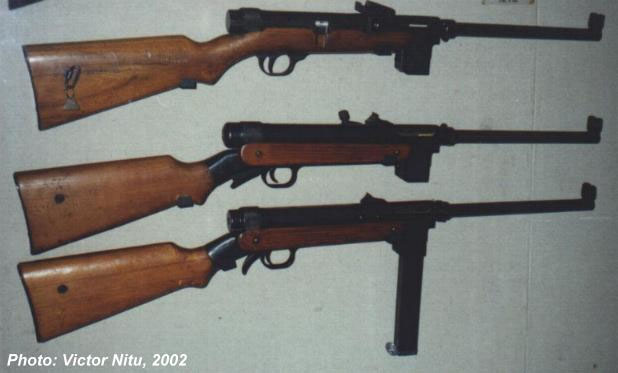
Although the Orita has the look of a stamped second-generation SMG like the MP41, it was actually much more like the precisely machined first generation of subguns. The receiver is a milled piece, and the gun is a sturdy and durable piece of kit.
Mechanics
The Orita fires from an open bolt, but it is a bit more complex in design than the typical open bolt gun. Instead of having a fixed firing pin, it uses a floating pin and lever system to fire. A projection on the front of the bolt slides backwards when it hits the barrel face, which forces a lever inside the bolt to rotate around a pivot point and strike the firing pin, which then hits the cartridge primer. This system is certainly more complex to manufacture than a simple fixed firing pin, but it prevents the possibility of an out of battery detonation. It is relevant to note, however, that this will not prevent accidental discharge as is possible with many open-bolt guns. If the bolt is closed over a loaded magazine and the stock struck against the ground, it is possible for the bolt the bounce back far enough to pick up a round form the magazine, which it will proceed to chamber and immediately fire.
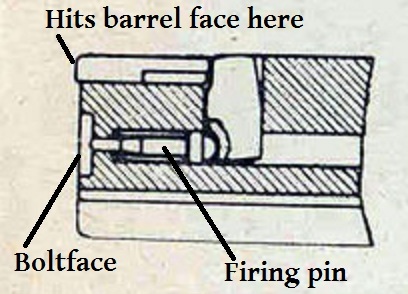
Beyond this, the mechanics of the Orita are pretty standard. It used a non-reciprocating charging handle on the left side of the gun. The magazine was a double stack, single feed type that held 32 rounds and was pretty similar in appearance (though not interchangeable with) to the MP40/41 magazines that were also in use by Romanian forces. The Orita mags can be distinguished by the deep guide grooves in both sides, which extend all the way up to the feed lips. The single-feed aspect meant that the mags were difficult to load by hand, and an interesting rotary loading tool was designed to go along with them.
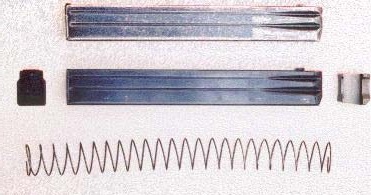
Variations
The first production version of the Orita had a number of relatively expensive features characteristic of early SMGs. The rear sight was a tangent type graduated from 100m out to 500m, and it had a crossbolt-type safety and a semi/full fire selector above the trigger. After the end of WWII the design was simplified, and fire selector was removed, making the trigger mechanism full auto only (with single shots to be made by trigger control on the part of the shooter). In addition, the manual safety was replaced by a grip safety on the underside of the wrist of the stock, and the rear sight was replaced by a simple two-position notch.
There were clearly some iterations between these two standards as well, as some photos show a grip safety and normal foreend (as below), while others show a metal wrist built into the receiver and wood panels added to the sides for a gripping surface (as in the two late model guns in the top photo). This might be explained by a combination of converted early guns and later guns built from scratch as second variants.
There are many brief references to a folding-stock version, but I have been unable to find any photos or firsthand evidence of these. If they were made, it would have been is quite small numbers.
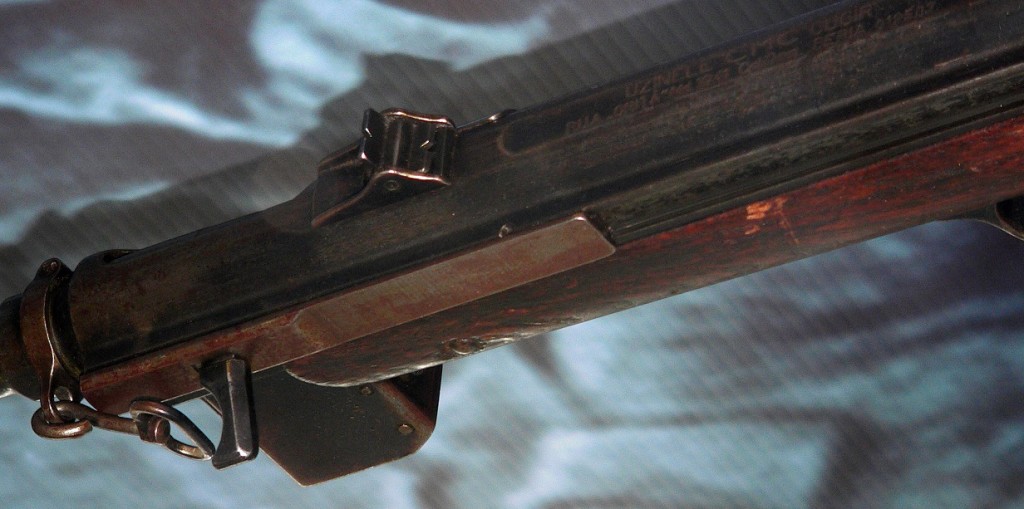
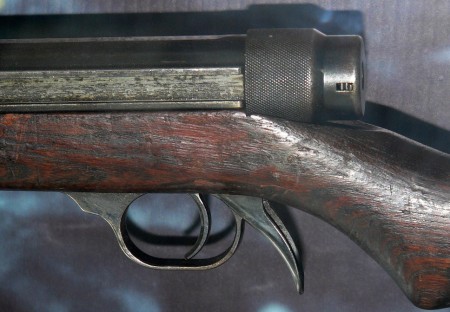
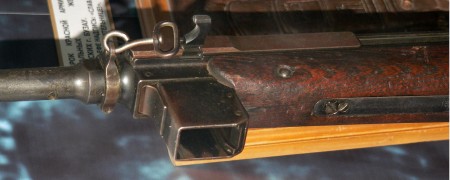
Usage
Ultimately, domestic production of the Orita could not keep up with the demand for submachine guns by the military, and Romania continued to use a wide variety of captured and purchased guns from other countries, including the MP41, ZK383, PPSh-41, Beretta M38A, and others. I found one reference to a total production of 4000 Oritas, but have not been able to confirm this.
The guns, while expensive to make, were pretty good in the field. After WW2 they continued to be used by the military well into the 1950s, and as late as the 1970s by national guard units. Eventually they were all replaced by AK rifles.
Technical Specs
Caliber: 9×19 mm
Mechanism: Plain blowback (unlocked)
Overall length: 35.2in (894mm)
Barrel length: 10.9in (278mm)
Sight Radius: 16.6in (422mm)
Sights: 100-500m tangent (early model) and two-position notch (late model)
Rifling: 6 groove, right-handed
Weight, empty: 7.6lb (3.45 kg)
Magazine capacity: 32 rounds
Rate of fire: 600 rpm
Photos
Thanks to Michael Heidler, we also have this set of photos of two second-model Orita guns, with slightly different styles of grip safety:
Additional Resources:
Liviu Plavcan has written the most detailed current article on the Orita: Romanian Firepower: 9mm Orita Model 1941 Submachine Gun
Yuri Pasholok has a series high resolution photos of a late model Orita, which show a lot of detail of the exterior: Orita SMG Walk Around


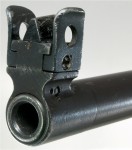








Thanks, Michael!
Hey Michael,
If you want i can drop by at the local military museum in (Oradea) Romania and send some more pictures of the Orita. It has both models side by side for a good comparison. (as far as i can remember)
“There are many brief references to a folding-stock version, but I have been unable to find any photos or firsthand evidence of these. If they were made, it would have been is quite small numbers.”
Here’s a few photos of the folding stock version:
http://img146.imagevenue.com/img.php?image=86284_IMG_4219_122_396lo.JPG
http://img103.imagevenue.com/img.php?image=86278_IMG_4218_122_771lo.JPG
http://www.tehnomil.net/wp-content/uploads/2015/09/Orita_pat_rabatabil.jpg
Thanks!
From the very little info and photos on this weapon, here is what I can say.
There are actually 5 different variants of the Orita SMG. Below a quick guide.
For lack of an official known desigantion of these sub-versions, we will arbitrarilly name them Variant 1 trough 5
The defining feature of the variant produced during war time is the one piece wooden stock, running continuously from the buttplate to the rear of the magazine well. This is the Orita Md 1941. 45.000 were ordered in 1942 – only a fraction of this number were built.
Variant 1
Serial production started in October 1942, with 666 built that month, out of the planned number of 1579. ID points are the ladder style rear sight, crossbolt safety in front of the trigger guard and a fixed charging handle, sticking to the left side, just above the front of the magazine well. Known serial is 002888. At some point during this production run, the safety was moved from the crossbolt to a metal plate on the right side of the receiver, below the rear sight.
Variant 2
This appeared sometime in 1943, with a few changes reflecting operational feedback from the campaign in the east. The rear sight was changed to a simpler 2 position notch, the safety was changed to a flap rear of the trigger guard which had to be squeezed in order to shoot (much easier to engage with gloved hands) and the charging handle was folding down (so as not to tangle with the soldiers gear), and was moved slightly to the back, aliginig roughly to the rear of the magazine well. Known serial is 012502.
The most visible feature of post-war modified examples is the three piece stock. The rear wooden stock was kept, but was attached to the rear of the receiver by a metal neck which housed the flap safety. The front part of the stock was ditched alltogether, and replaced by two pieces of wood with long horizontal grooves, bolted to the sides of the receiver. The fire selector was removed, guns being full auto only.
Variant 3
These appear to be remanufactured / modified Variant 2 weapons, with the stock modifications mentioned above. They kept the markings on top of the receiver (Md 1941), but some have an additional plate on the right side of the receiver which reads modified 1948. Known serials are 005172, 005654, 07468, 012276, 012278, 017688
Variant 4
Judging by their features and serial range, these appear to be remanufactured / modified Variant 1 weapons, with the stock modifications mentioned above. Besides that, the fixed charging handle was removed and replaced by a flat screw, a new charging handle was bolted to the rear of the charging piece, its small cylindrical knob being visible from both left and right, on top of the receiver just behind – and to the left – of the rear sight. Safety is no longer a simple flap, it is a U shaped piece of sheet metal, so there is no gap between the safety and the neck of the stock (as it was the case on Variants 2 and 3). Another change is the receiver endcap is slightly rounded to the rear, whereas on the previous variants it was straight. They are marked UMC Automatic 49. Known serials are 00662, 03658
Variant 5
Has all the ID points of the Variant 4, but with a pistol grip and underfolding metal stock. Unknown designation and serials. Unknown if these are newly built receivers or modified / rebuild wartime production guns.
The vast majority of the guns still in inventory were modified in 1948/49. Photos of the patriotic guards from the 70s and 80s show mostly Variant 3 and 4 guns, with one or two Variant 1 or 2 showing up. In the late 80țs the guns were stored, most being scrapped in 1998.